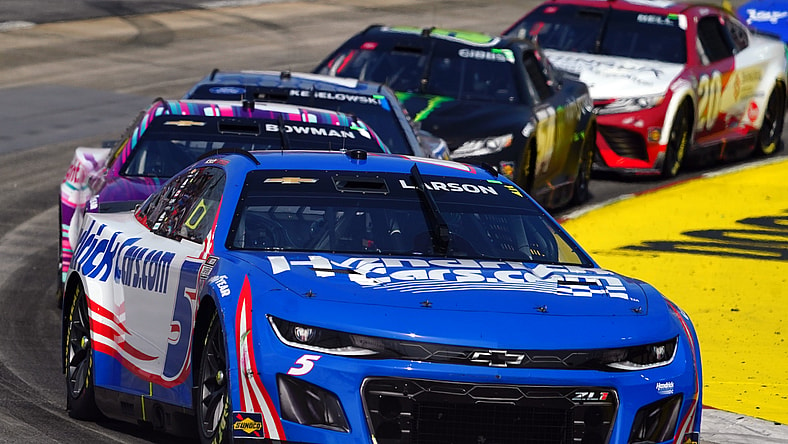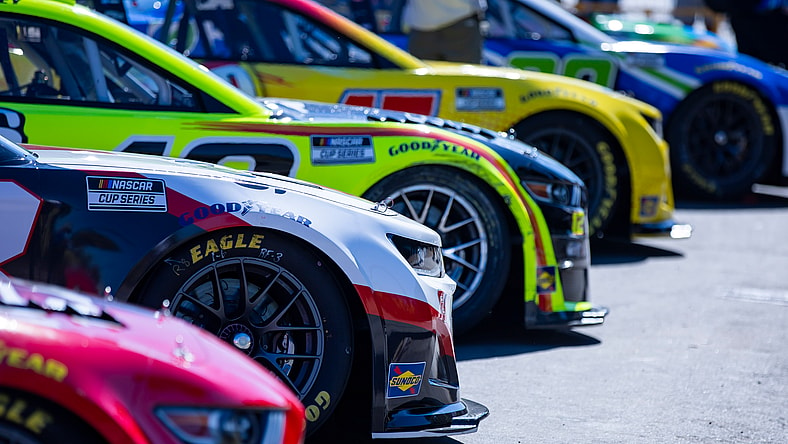
UPDATE:
The short track rules package being tested after next weekend’s race centers around a new splitter that intends to create lift in clean air and downforce when in traffic. It’s effectively a reverse splitter.
In other words, if ordinarily, the leading car has the most downforce on the nose of their cars because they have clean air and the trailing cars suffers push behind the leader, this splitter will reverse that effect.
The leader would have reversed splitter that creates lift while in clean air, essentially bogging the leader down while allowing the trailing car to compensate by reversing the splitter and creating downforce in dirty air.
It was described best by Christopher Bell on Saturday at Atlanta Motor Speedway.
“It creates lift in clean air,” Bell said. “The goal is, when you get into traffic and lose airflow to your splitter, it gives you more downforce than you would by yourself.”
Cup Series veteran Denny Hamlin says it will come down to the tire compound Goodyear matches with such a package.
“Generally speaking, there’s some merit to it,” Hamlin said. “You’re still less downforce than you would generally think if you were running behind someone, just total.
“So, how are cars perform well on a bigger track is that we can just go to a different groove to get air on our cars. If our cars now have less benefit to running in a different line, then I’m worried about the ability to pass being tougher. But again, I think it’s linked to the tires. The less downforce we have, the less the tires are going to wear so I think it’s down to Goodyear to be more aggressive yet with their tire package, giving us more grip because the lower downforce is not going to wear out tires.
“We need downforce to wear out tires.”
The natural pushback is that a splitter that generates drag and lift for the leader would essentially punish that car. Hamlin doesn’t entirely worry about that.
He’s especially fixated on the tire compound.
“Less downforce in general means less tire wear,” Hamlin said. “We would be better as a sport in my opinion, and it’s unproven, to have way more downforce and way more tire falloff because that would create way more lap time differentiation from those who have tires or don’t have tires, because that’s how passing happens versus everyone being the same.
“If everyone is the same, you just get a conveyor belt. I don’t think you can take downforce off unless you match it with the tire. That could have a negative change, but I also know they’ve worked on the tire for New Hampshire.”
Hamlin is hopeful, even if this rules package doesn’t make its way into competition this season, that the tire compound ultimately gets used for the Cup Series championship race at Phoenix.
“That track has an awful track record when it comes to passing,” Hamlin said. “If it’s successful at New Hampshire, they should definitely copy and paste it for Phoenix.”
—
The second year NextGen car remains a work in progress, especially when it comes to producing more action on short tracks and road courses, so the league is set to take another swing at it next week following the New Hampshire Motor Speedway race.
NASCAR is expected to take six cars on Monday after the Cup race and turn laps with a modified underwing, while also pairing it with a variety of additional downforce settings, with the goal of creating more passing on short tracks.
The exact parameters of the test could be made public next week. That includes the teams and drivers expected to participate. Any changes that ultimately come from New Hampshire will likely not make their way into a rule book until next season.
To understand how NASCAR is working to solve the challenge, it’s important to realize how it landed there in the first place. The still new racing platform is heavily based off an Australian Supercar and is the first NASCAR national touring machine to incorporate a sealed underbody.
The underbody is part and parcel of several elements designed to generate downforce and create stability for the cars while they rotate through the corners. While the car has been a directional improvement from its predecessor on intermediate (mile-and-a-half) tracks, it creates too much downforce and dirty air on short tracks.
Combined with tires that create a wider contact patch, a larger brake package and reduced RPMs that encourages drivers to downshift in the corners, the end result is a car that relatively drives too good, stops too good and stifles passing on the shortest and tightest tracks on the schedule.
The air off the rear spoiler of a leading car causes its pursuer to push up the track on corner entry. If the leading car overshoots the corner, its driver can simply downshift, effectively settling the car and allowing its driver to drive off without consequence.
NASCAR took a swing earlier this season by reducing overall downforce counts by 30 percent through a shortening of the rear spoiler and changes to the underbody but 2020 Cup Series champion Chase Elliott says he hasn’t noticed a significant change when it comes to the dirty air.
“I missed a lot of the races this year when they took some spoiler away and changed the underbody for the short tracks and road courses and they don’t feel any different to me,” Elliott said when asked about the topic by Sportsnaut in a teleconference. “I missed the first couple of races, and I came back at Martinsville and it was with that package.
“If you would have told me that nothing changed, I would have believed you.”
NASCAR makes configuration changes

So, NASCAR is going to try again after next weekend with more changes to the underbody and overall downforce configurations. The goal is to provide a trailing car the front downforce it loses behind a leading car.
“They’re trying a new aero package with a different splitter and a whole different philosophy,” said Spire Motorsports driver Corey Lajoie. “They’ve seen a lot of success with the (computational fluid dynamics) testing. The thought process behind it is freaking wild.”
The long-held conviction amongst drivers is that more horsepower would go along way to fixing all of this, but NASCAR is resolute in its current policy of restricting engines nominally capable of producing over 900HP to a target of 670HP for cost reduction reasons.
That point was again illustrated by Kaulig Racing veteran AJ Allmendinger who also underscored the need to fix the turbulence issue.
“Everyone brings up horsepower so we would have more off-throttle time in the corners, but I don’t get consumed with it because it’s not my job to worry about it,” Allmendinger said. “At the end of the day, we have a lot of smart people working on making this car better, aerodynamically, and that’s the biggest thing.
“If we can make this car better in dirty air, that’s the biggest thing, but I don’t have an answer. There are people way smarter than me working on this, but to me, if drivers (tell NASCAR) a certain change makes it better in dirty air, that’s going to make the racing better.”
To his point, Legacy Motor Club driver Erik Jones says NASCAR has never been more receptive to the drivers than they have been over the last calendar year or so when it comes to making inroads on the short track and road course passing problem.
“Man, I first came here in 2017 and at the time, there were no meetings, no communication with NASCAR on the competition front,” Jones told Sportsnaut last month. “Over the last, well since this car came out and at the end of the last car, we are having almost monthly competition meetings at the tracks with NASCAR.
“Obviously, it started in the off-season and having a good amount of input.”
To his point, NASCAR was almost dead set on trying to force this car to draft like it was a superspeedway race at every intermediate track as an extension of the 550 rules package used in the final years of the previous generation Cup car.
Drivers pushed back incredibly hard during a test at Charlotte Motor Speedway in November of 2021 and it led to a meeting in Downtown Nashville before the championship banquet where NASCAR agreed to a horsepower increase and downforce reduction.
“We plead with them to go to the higher horsepower and lower downforce and it has turned out pretty good,” Jones said. “I think that inspired some confidence within them to develop some of the things we’ve asked for.
“I think this New Hampshire test coming up is going to be more of that and they’re trying to develop some of that even further. It has been way more communication than I have ever had with NASCAR, and not just over text, but face-to-face and month-to-month and we’re all grateful for that.”
Specific to New Hampshire, there was a tire test there on April 25 that Elliott participated in that changed his entire view point to what NASCAR could do to make progress.
“I thought we made a lot of gains on the tire during that test and it opened my eyes to how much we can make things with just the tire compound by itself and that really surprised me,” Elliott said. “For a long time, and I still feel like Goodyear is in a tough place, because they feel like if tires fail, then it could hurt their sales on Monday.
“But (they) have to make a tire that is a little closer to the edge than they’ve (given us) in the past. That puts some responsibility on the teams to live within those guidelines, the livable zone of the tires, and that has to fall to the teams.”
Elliott is referring to tire failures that are occasionally the result of aggressive camber and air pressure setups. It’s a fine line between finding speed and doing damage to the tire and teams often default to blaming Goodyear when crew chiefs chose to exceed the recommended set-up.
The second-generation racer is saying that Goodyear can afford to be more liberal with the tire compound, but teams have to lay off the manufacturer should they suffer failures due to their set-up decisions.
“So, overall, I was excited about the things we saw there with what we could do with a good tire compound,” Elliott said. “It also made me extremely optimistic that they could do it and do it well.
“So, I don’t know what the test will bring this time around, but I will say this: I think we can make gains in every area, but the tire is the area that I see us being able to move the needle in quite a lot.”
Matt Weaver is a Motorsports Insider for Sportsnaut. Follow him on Twitter.